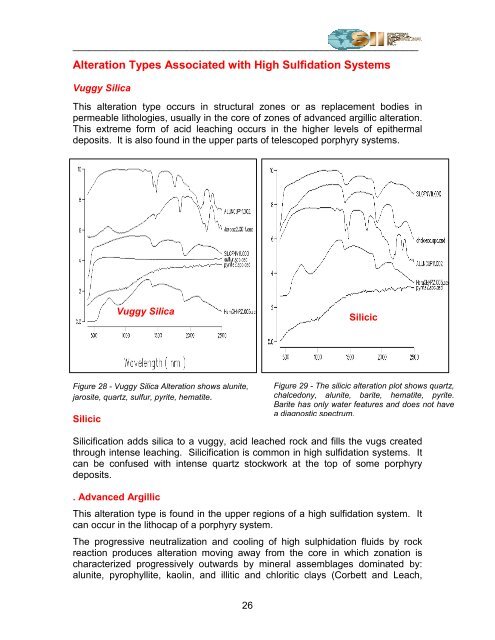An overview of vis-nir-swir field spectroscopy - Spectral International
An overview of vis-nir-swir field spectroscopy - Spectral International
An overview of vis-nir-swir field spectroscopy - Spectral International
You also want an ePaper? Increase the reach of your titles
YUMPU automatically turns print PDFs into web optimized ePapers that Google loves.
________________________________________________________________<br />
Alteration Types Associated with High Sulfidation Systems<br />
Vuggy Silica<br />
This alteration type occurs in structural zones or as replacement bodies in<br />
permeable lithologies, usually in the core <strong>of</strong> zones <strong>of</strong> advanced argillic alteration.<br />
This extreme form <strong>of</strong> acid leaching occurs in the higher levels <strong>of</strong> epithermal<br />
deposits. It is also found in the upper parts <strong>of</strong> telescoped porphyry systems.<br />
Figure 28 - Vuggy Silica Alteration shows alunite,<br />
jarosite, quartz, sulfur, pyrite, hematite.<br />
Silicic<br />
Vuggy Silica<br />
Silicification adds silica to a vuggy, acid leached rock and fills the vugs created<br />
through intense leaching. Silicification is common in high sulfidation systems. It<br />
can be confused with intense quartz stockwork at the top <strong>of</strong> some porphyry<br />
deposits.<br />
. Advanced Argillic<br />
This alteration type is found in the upper regions <strong>of</strong> a high sulfidation system. It<br />
can occur in the lithocap <strong>of</strong> a porphyry system.<br />
The progressive neutralization and cooling <strong>of</strong> high sulphidation fluids by rock<br />
reaction produces alteration moving away from the core in which zonation is<br />
characterized progressively outwards by mineral assemblages dominated by:<br />
alunite, pyrophyllite, kaolin, and illitic and chloritic clays (Corbett and Leach,<br />
26<br />
Silicic<br />
Figure 29 - The silicic alteration plot shows quartz,<br />
chalcedony, alunite, barite, hematite, pyrite.<br />
Barite has only water features and does not have<br />
a diagnostic spectrum.


